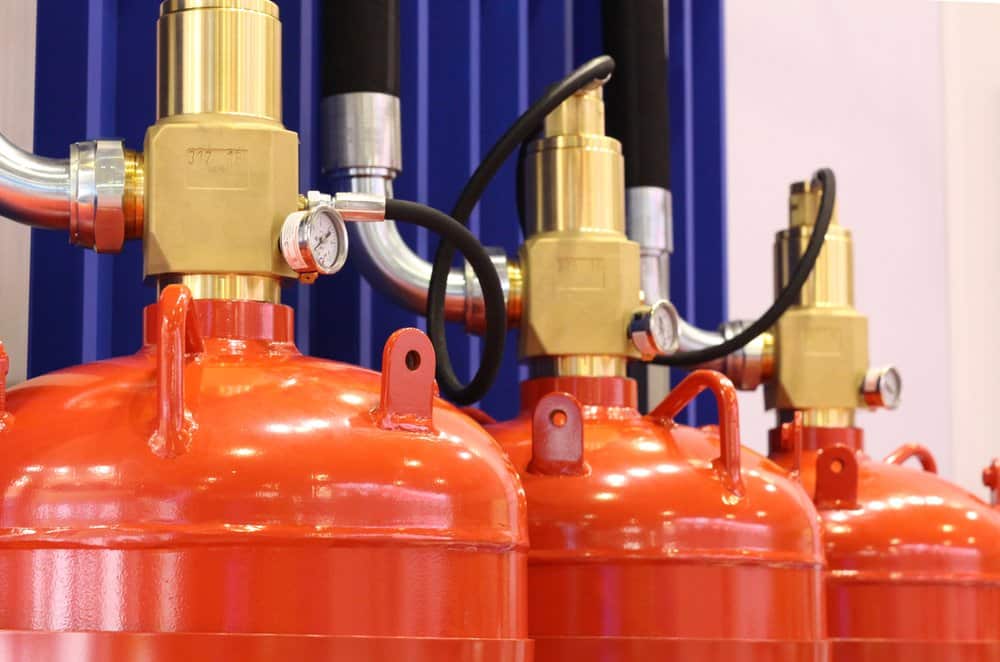This is the second of our four-part series on clean agent fire suppression systems. This series aims to educate organizations on various types of special fire hazard solutions (FM-200, ANSUL INERGEN, 3M Novec 1230, and different types of CO2), helping them to gain a better understanding of the best option for their facility.
Clean Agent Series: ANSUL INERGEN
Clean agents are fire extinguishing materials that are electrically non-conducting, volatile, or gaseous, and that don’t leave residue upon evaporation. They’re a key part of many industrial facilities’ fire suppression systems, especially ones that house sensitive and/or high-value materials.
In the previous installment of our clean agent series, we discussed FM-200, a popular, yet controversial clean agent that’s soon to be phased out due to its harmful amount of Hydrofluorocarbon gasses (HFCs).
In this article, let’s take a look at another common clean agent — but this time one that’s not going to be phased out anytime soon: INERGEN. We’ll talk about its fire extinguishing properties, common applications, and unique benefits.
What Is INERGEN?
INERGEN, which is manufactured by ANSUL, is a clean agent fire suppressant for Class A, B, and C fires. It’s composed of a mixture of three naturally occurring gasses: 52% nitrogen, 40% argon, and 8% carbon dioxide. It’s a safe, non-toxic, non-corrosive fire extinguishing agent that leaves no residue upon discharge. For these reasons, it’s a great choice for fire suppression systems within high-risk facilities that house sensitive products.
How Does INERGEN Work to Combat Fires?
A fire can only occur when three elements are present: heat, oxygen, and a fuel source. Therefore, in order for any clean agent to effectively quench a fire, it must disrupt at least one component of this “fire triangle.” The three gasses that make up INERGEN’s composition work to lower the oxygen level below one that supports combustion, while still maintaining a safe amount of oxygen so humans can breathe.
Which Industrial Applications is INERGEN Used For?
INERGEN can be used in many different industries, but is especially common among the following applications:
- Hospitals and other major medical facilities
- Telecommunications centers
- Computer and data processing centers
- Power generation facilities
- Marine, offshore, and naval facilities
- Museums and art galleries
- Cultural and historical sites
The Benefits of Using INERGEN As a Clean Agent in Your Facility
As with any clean agent, the most important benefit of using INERGEN as part of your facility’s fire suppression system is that it won’t leave residue upon evaporation or destroy your property. But there are a few other aspects that make it a great choice as well, such as:
- It’s the safest inert gas agent. Non-toxic to humans, INERGEN is the safest inert gas at design concentration. It reduces oxygen to a level that prevents combustion but still allows humans to breathe.
- It’s non-synthetic. INERGEN is made of naturally occurring gasses instead of manmade materials, adding another layer of safety and sustainability to the mix.
- It’s not harmful to the environment. INERGEN has been tested to have zero ozone depletion potential, zero global warming potential, and zero years of atmospheric lifetime. All this means that 1) it’s not harmful to the environment, and 2) it won’t be subject to future legislative bans like FM-200.
- It comes with a best-in-class warranty program. ANSUL’s Evergreen Discharge Warranty offers all customers no-cost INERGEN replacements for up to 20 years, no matter the cause of the discharge.
Get INERGEN Clean Agent Solutions at Vanguard
At Vanguard Fire & Security Systems, we offer a variety of clean agent fire suppression products, such as FM-200, ANSUL INERGEN, 3M Novec 1230, and CO2. If you work in an environment that requires fire protection for special hazards, we can help you find the clean agent that will best protect your property, products, and people. Contact us today.


